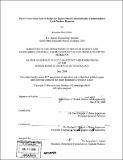| dc.contributor.advisor | Pravel Hejzlar and Michael J. Driscoll. | en_US |
| dc.contributor.author | Gibbs, Jonathan Paul | en_US |
| dc.contributor.other | Massachusetts Institute of Technology. Dept. of Nuclear Science and Engineering. | en_US |
| dc.date.accessioned | 2009-03-16T19:40:13Z | |
| dc.date.available | 2009-03-16T19:40:13Z | |
| dc.date.issued | 2008 | en_US |
| dc.identifier.uri | http://hdl.handle.net/1721.1/44765 | |
| dc.description | Thesis (S.M.)--Massachusetts Institute of Technology, Dept. of Nuclear Science and Engineering, 2008. | en_US |
| dc.description | "June 2008." | en_US |
| dc.description | Includes bibliographical references. | en_US |
| dc.description.abstract | The supercritical carbon dioxide (S-CO₂) cycle is a promising advanced power conversion cycle which couples nicely to many Generation IV nuclear reactors. This work investigates the power conversion system design and proposes several "Third Generation" plant layouts for power ratings ranging between 20 and 1200 MWe for the recompression cycle. A 20 MWe simple cycle layout was also developed. The cycle designs are characterized by a dispersed component layout in which a single shaft turbomachinery train is coupled to parallel arrays of multiple printed circuit heat exchanger modules. This configuration has arrangement benefits in terms of modularity, inspectability, repairability and replaceability. Compared to the prior second generation dispersed layouts, its lower ductwork pressure drop confers approximately 2% higher thermal efficiency. Two alternative S-CO₂ cycle designs for medium power applications were developed using an in-house optimization computer code and Solid Edge software. The first design is a recompression cycle derived from the 300 MWe design developed at MIT for Generation IV reactors. The design employs one turbine, two compressors (main and recompression) working in parallel and two recuperators (high and low temperature) and maximizes cycle efficiency while striving for a small plant footprint. The second design is a simple S-CO₂ power cycle, which has only one turbine, one compressor, and one recuperator. The main focus of the simple S-CO₂ design is cycle compactness and simplicity while achieving still attractive efficiency. Extensive sensitivity studies were performed for both the medium power recompression and simple S-CO₂ cycles to reveal areas for performance improvement, or performance degradation. Cycle efficiency is most sensitive to turbine inlet temperature. | en_US |
| dc.description.abstract | (cont.) Peak cycle pressure is also an important parameter affecting cycle efficiency, although to a smaller extent than turbine inlet temperature. Higher pressure gives higher efficiency, but this gradually saturates around 28 MPa. Other sensitivity studies included turbomachinery performance, cooling water temperature, and heat exchanger fouling and plugging The reference parameters chosen are a 650°C turbine inlet temperature and 20 MPa peak cycle pressure (compressor outlet) because they reach a high thermodynamic efficiency (~/~47-48%) while staying within materials limitations. In order to couple the cycle to many of the Generation IV nuclear reactors a second reference case was chosen with a turbine inlet temperature of 550°C and a peak cycle pressure of 20 MPa. | en_US |
| dc.description.statementofresponsibility | by Jonathan Paul Gibbs. | en_US |
| dc.format.extent | 207 p. | en_US |
| dc.language.iso | eng | en_US |
| dc.publisher | Massachusetts Institute of Technology | en_US |
| dc.rights | M.I.T. theses are protected by
copyright. They may be viewed from this source for any purpose, but
reproduction or distribution in any format is prohibited without written
permission. See provided URL for inquiries about permission. | en_US |
| dc.rights.uri | http://dspace.mit.edu/handle/1721.1/7582 | en_US |
| dc.subject | Nuclear Science and Engineering. | en_US |
| dc.title | Power conversion system design for supercritical carbon dioxide cooled indirect cycle nuclear reactors | en_US |
| dc.type | Thesis | en_US |
| dc.description.degree | S.M. | en_US |
| dc.contributor.department | Massachusetts Institute of Technology. Department of Nuclear Science and Engineering | |
| dc.identifier.oclc | 300273946 | en_US |

